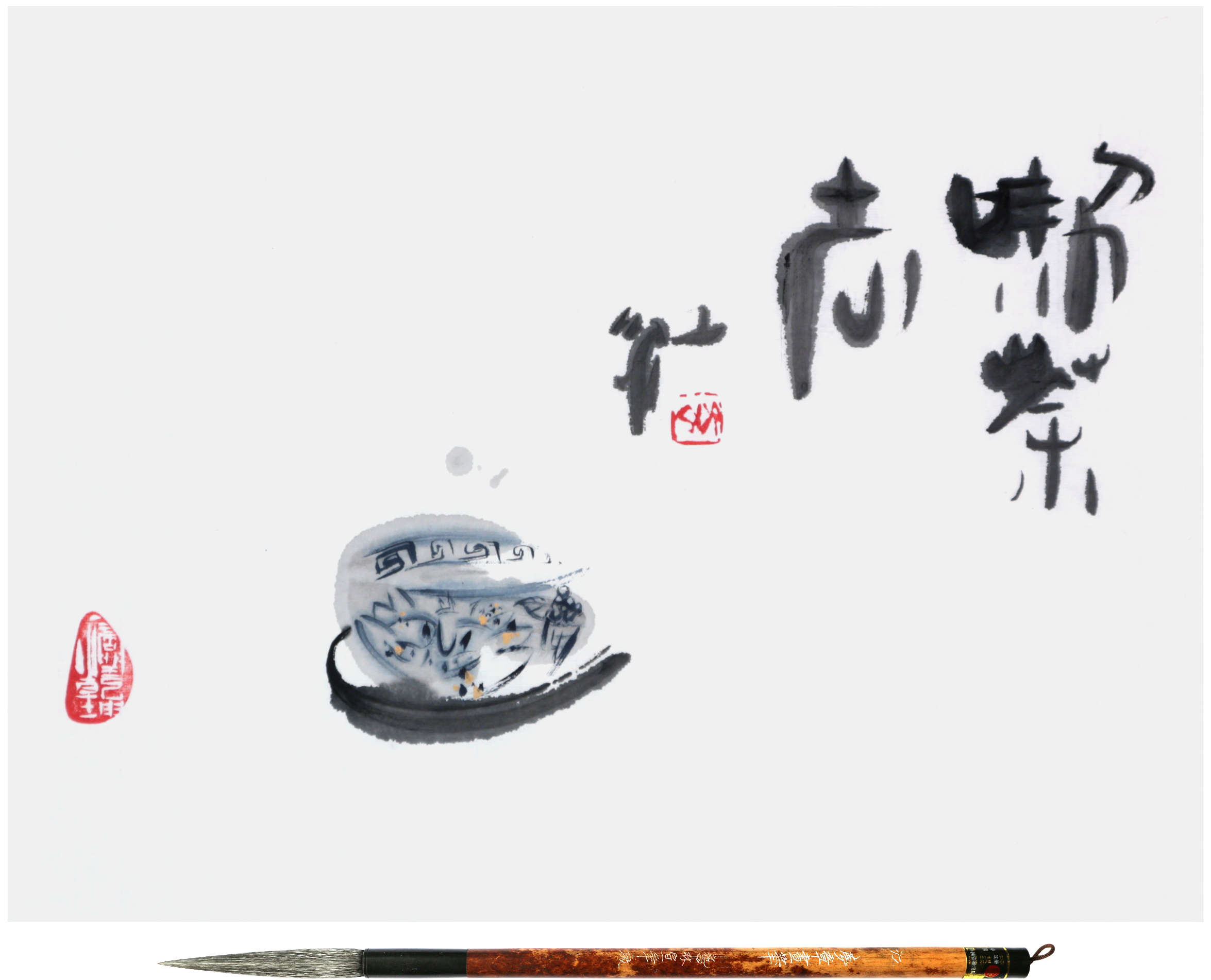 |
|
|
The Example of Sai Koh (Qi Hong)’s Freehand Brushwork
Traditional Chinese Painting and Calligraphy on Tea:
Chinese painting (still life painting, literati painting, ink
wash painting), Chinese calligraphy (semi-seal
script calligraphy), Chinese seal engraving (Chinese seal
carving, Chinese seal cutting)
A Cup of Tea
ink & color on Xuan paper, 2016
Inscriptions: Go for tea. Koh (Hong); Chinese,
喫茶去 紅 (Literary quotation: Wu Deng Hui Yuan (Combined Sources
for the Five Lamps) written by Puji in the Song Dynasty)
Seal: Sai (Qi); Chinese, 齊 A Drop of Water
Moistens the Universe; Chinese, 一滴潤乾坤
Xuan Paper: Mian Liao Mian Lian, 46×34cm
Brush: Goat Hair Long Head Brush, Meng Zhang
Hua Bi · Jiang
|
|
|
|
|
|
View 1 |
The Innate Excellent Carrier of Traditional Chinese Painting and
Calligraphy Art - Water
|
|
|
When I was little, I didn’t have any
toys. What amused me at that time was either rushing to help my
dad rub an ink stick or scribble drawings on the newspaper with
my dad’s writing brush. In a flash, forty years have passed. The
intrinsic things of these “toys” have become integral to my life
and can no longer be separated.
What attracts me the most in
traditional Chinese painting and calligraphy is that “water
trail or water halo” can be used to clearly record and vividly
reproduce the aesthetic pursuit that is consistent with the
physical and mental state of the calligrapher or the painter.
Rubbing an ink stick made me slowly
know that “Water can be thick, thin, wet or dry”, and scribbling
on the newspaper made me know a little bit that “There is a
sequence in the accumulation and release of water. The swelling
of water on the drawing paper can be fast or slow. Water trails
are superimposable.” And learning my father’s painting made me
gradually know that only when I understand the meaning of “water
moves itself” can my painting get closer to the original.
“Water itself has no shape, but the
ink shows the shape of water.” The thick, light, wet or dry ink
color let me slowly see the origin of the “water halo” on the
dry paper, and the origin of the "water halo" makes me slowly
see the creator's physical and mental state recorded and
reproduced in the works at that time and his colorful pursuit of
aesthetics. |
|
|
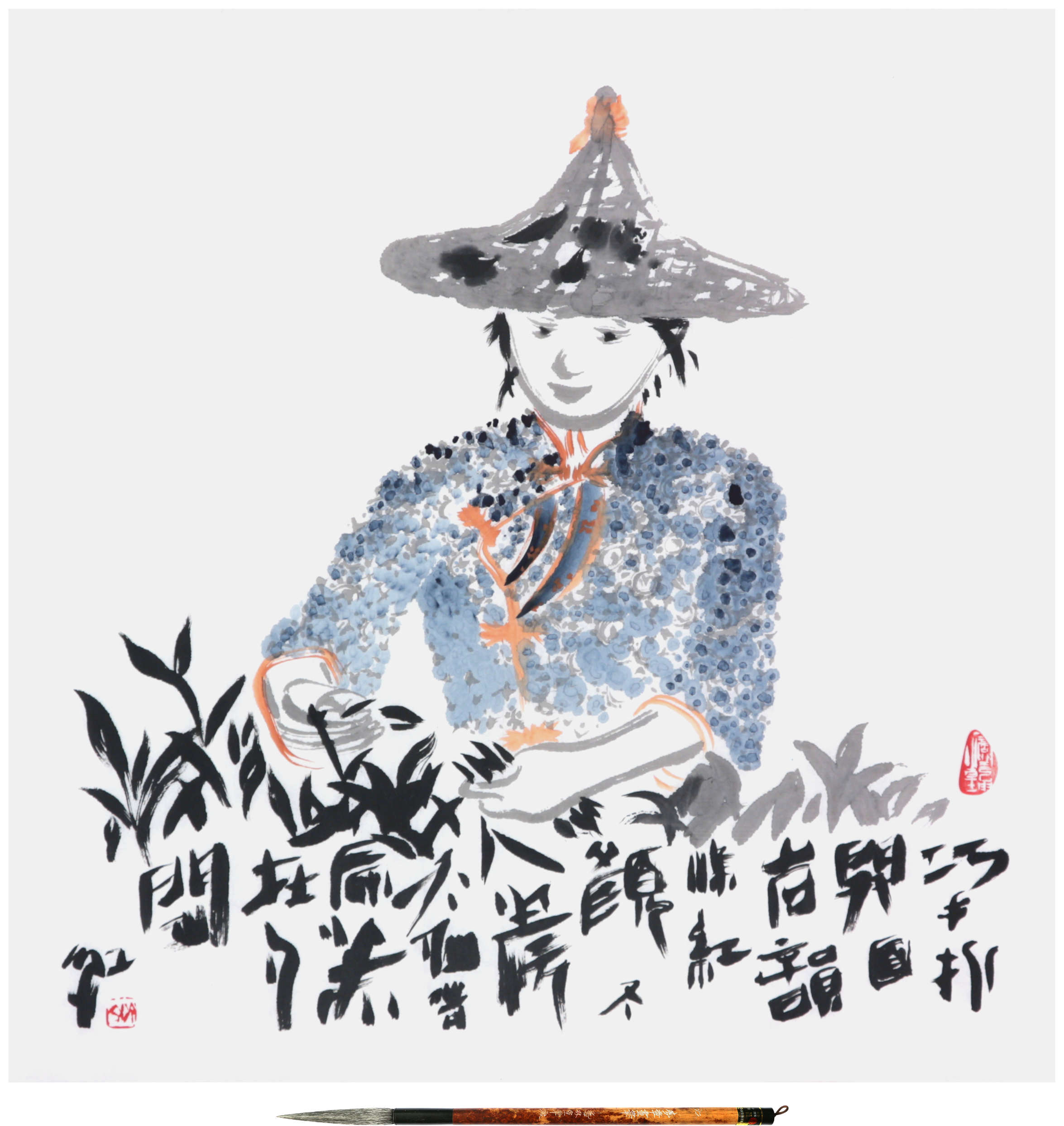 |
|
|
The Example of Sai Koh (Qi Hong)’s Freehand Brushwork
Traditional Chinese Painting and Calligraphy on Tea:
Chinese painting (figure painting, literati painting, ink wash
painting), Chinese calligraphy
(semi-seal script calligraphy), Chinese seal engraving (Chinese
seal carving, Chinese seal cutting)
A Tea-picking Girl in Mount Wuyi
ink & color on Xuan paper, 2017
Inscriptions: How dexterous the hands of the
tea picker are. Look at rock charm reflecting on the beauty’s
face. Don't envy the fairies living in the heaven since the most
gorgeous still exists on earth. Koh (Hong); Chinese, 巧手折開面 嚴韻染紅顏
不羨天仙倩 最美在人間 紅
Seal: Sai (Qi); Chinese, 齊 A Drop of Water
Moistens the Universe; Chinese, 一滴潤乾坤
Xuan Paper: Mian Liao Mian Lian, 69×68cm
Brush: Goat Hair Long Head Brush, Meng Zhang
Hua Bi · Jiang
|
|
|
The Basic
Carrier of Traditional Chinese Painting and Calligraphy Art
–“Water”
Traditional Chinese painting and
calligraphy can be said to be a visual art made by using “water
trail and water halo”. The feelings and spiritual fluctuations
caused by the work are determined by the interaction between the
viewer and the works. At the same time, Traditional Chinese
painting and calligraphy can also be said to be the reproduction
of the author's aesthetic pursuit consistent with his physical
and mental state on the paper with the "water halo". What
content can be recorded and reproduced by the works can be said
to ultimately depend on the "techniques realm of knowing and
using water" of the painter or calligrapher.
It can be known from the unearthed
authentic handwritings such as “Wen County Alliance Oath”,
“Houma Alliance Oath”, “Chu Silk Manuscripts from Zidanku” and
“Yunmeng Shuihudi Qin Bamboo Texts Inscribed Wooden
Tablet” that the history of
traditional Chinese painting and calligraphy recorded and
reproduced by "water halo" can be traced back to the Spring and
Autumn Period more than 2,500 years ago. In the Wei and Jin
Dynasties, traditional Chinese painting and calligraphy had
basically completed the transformation from practicality to
combination of practicality and artistry. The invention of paper
in the Han Dynasty and the appearance and popularization of rice
paper after the Sui and Tang Dynasties further enriched and
stabilized the recording and reproduction effect of “water
halo”, making the unique artistic charm of traditional Chinese
painting and calligraphy created by “water” as the basic carrier
even more changeful and colorful.
|
|
|
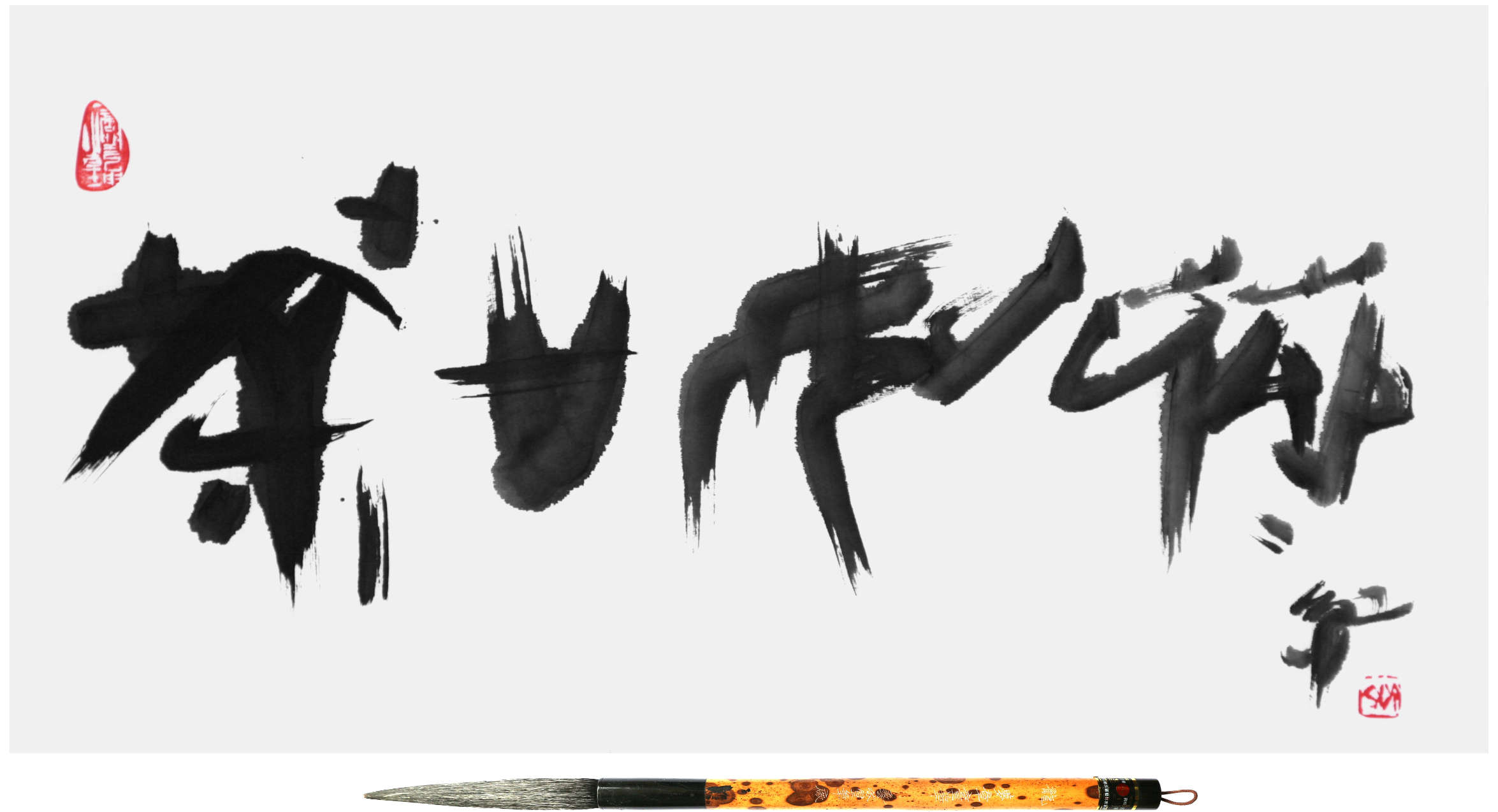 |
|
|
The Example of Sai Koh (Qi Hong)’s Freehand Brushwork
Traditional Chinese Painting and Calligraphy on Tea:
Chinese calligraphy (semi-seal script calligraphy), Chinese seal
engraving (Chinese seal carving, Chinese seal cutting)
The Bitter Tea Tastes as Sweet as the Shepherd's
Purse
ink on Xuan paper, 2017
Pinyin: tu gan ru ji; Chinese, 荼甘如薺 紅(Literary
quotation: The Odes of Gu, The Odes of Bei, The Classic
of Poetry in the Spring and Autumn Period)
Seal: Sai (Qi); Chinese, 齊 A Drop of Water
Moistens the Universe; Chinese, 一滴潤乾坤
Xuan Paper: Mian Liao Mian Lian, 69×34cm
Brush: Goat Hair Long Head Brush, Meng Zhang
Hua Bi · Long
|
|
|
The Basic
Pursuit of Traditional Chinese Painting and Calligraphy Art
–“Individualization • Vividness in Form and Spirit •
Expressiveness in Freehand Brushwork”
Compared with the realistic representation in western paintings,
which focuses on the “light and shadow relationship on the
plane” and emphasizes on perspective proportion and “stacked
planes”, the traditional Chinese painting and calligraphy
focuses on the “sparse and dense relationship on the plane”,
emphasizes on the "line drawing" that expresses the unity of
form and spirit, and presents the invisible lively freehand
brushwork with visible lines. This aesthetic ideology that
focuses on pursuing the individualization of the “line drawing”
image, keeping the physical and mental state consistent with the
internal subjective emotional activities, conveying the
vividness in form and spirit and expressiveness in freehand
brushwork is gradually developed and perfected in the long
history of Chinese history with common origins of calligraphy
and painting.
From archaeological discoveries such as carved symbols and
pottery paintings in the prehistoric Neolithic era, it can be
known that "line drawing" was an important means of shaping
during the initial period when both characters and paintings
were chaotic. As far as “line drawing” is concerned,
“handwritten line drawing” that is independent of tools such as
rulers can be said to be the form that best reflects human
personality. Even handwriting identification is still used to
determine the individuality of “handwritten line drawing” in
modern society. And signatures of "handwritten line drawing" are
still used to represent individuality to this day.
In China, since the birth of the Chinese civilization, the
"handwritten line drawing"-Chinese characters, which is very
common in daily life, has gone through the following
stages: carved marks, oracle bone script, Jinwen (inscriptions
on ancient bronze ware), Xiaozhuan (the lesser seal style
Chinese characters of the Qin Dynasty (221-206 BC)), Lishu (the
official script of the Han Dynasty (206 BC-220 AD)), and Kaishu
(the regular script of today). The innate ideographic structural
characteristics of Chinese characters indicate that Chinese
characters are not alphabetic writing of simple symbols but are
the result of the combination of the subjective activities of
human brain thinking such as induction, generalization and
refinement with the external objective natural objects.
Therefore, the "handwritten line strokes" of Chinese characters
have the freehand brushwork characteristics of expressiveness
through form. It can be said that calligraphy is a mixture of
both characters and paintings with a unique visual art
sensibility beyond the common alphabetic writing.
Since the Wei and Jin Dynasties, with the ever-changing
development of Chinese characters and paintings with
“handwritten line drawing” as the main shaping means from
practicality to a combination of practicality and artistry, the
calligrapher and painter's aesthetic pursuit of “handwritten
line drawing” becomes more and more colorful because it
completely consists with this carrier, reflects the same origin
of painting and calligraphy and draws freehand brushwork with
the shape. It not only includes the practical pursuit of
portraying and reproducing the text structure or objective
object image but also emphasizes individualized freehand
aesthetic pursuit of expressing subjective activities. This
gradually formed the unique aesthetic thought of Chinese
painting and calligraphy, which not only emphasizes the
consistency between the artist’s personal physical and mental
state and his subjective aesthetic pursuit but also stresses
vividness in form and spirit and expressiveness in freehand
brushwork.
|
|
|
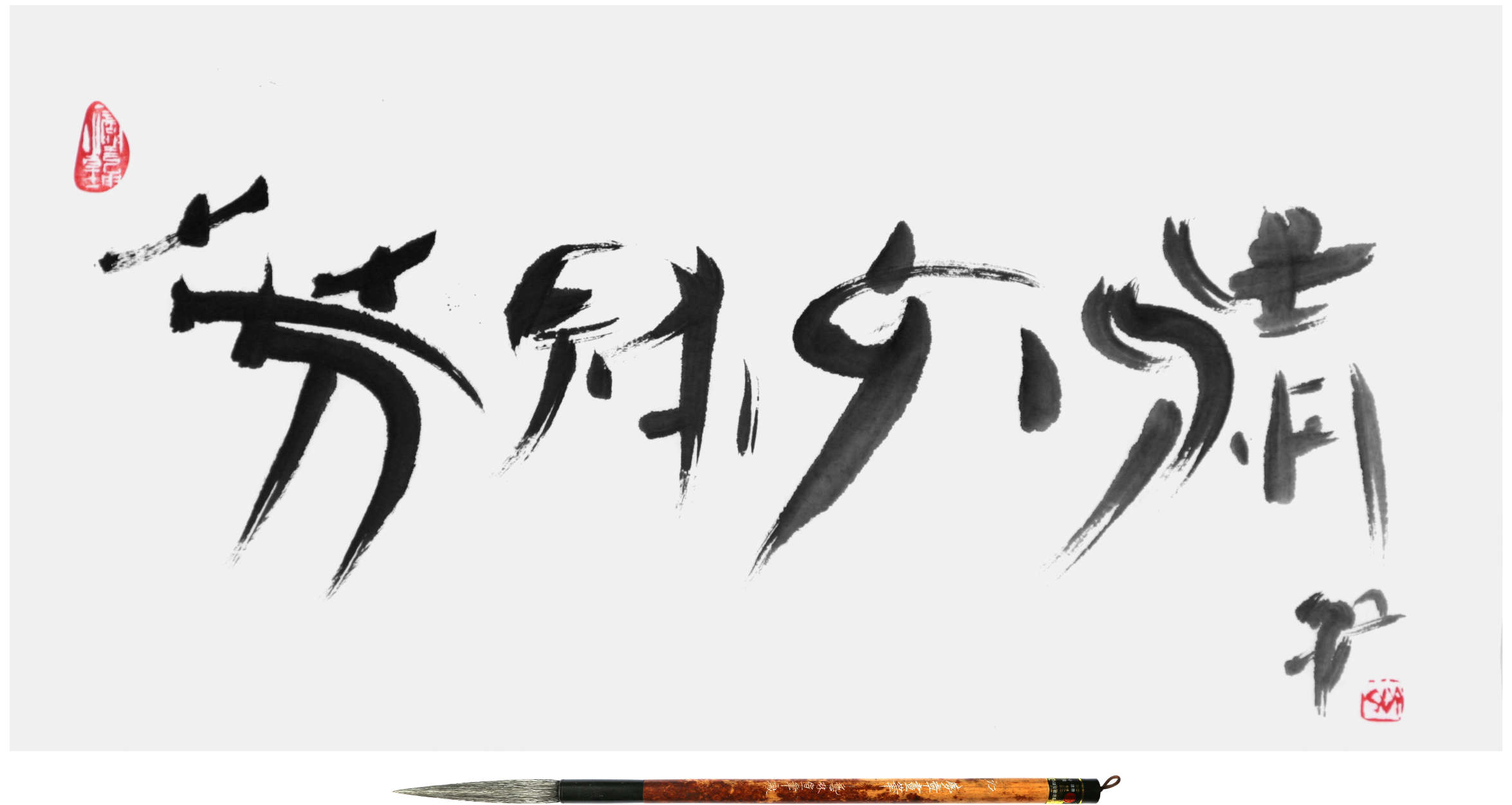 |
|
|
The Example of Sai Koh (Qi Hong)’s Freehand Brushwork
Traditional Chinese Painting and Calligraphy on Tea:
Chinese calligraphy (semi-seal script calligraphy), Chinese seal
engraving (Chinese seal carving, Chinese seal cutting)
The Fragrance of Tea Excels the other Six Beverages
ink on
Xuan paper, 2017
Pinyin: fang guan liu qing; Chinese, 芳冠六清 紅
(Literary quotation: Climbing Chengdu's Bai Tu Tower
written by Zhang Zai in the Western Jin Dynasty )
Seal: Sai (Qi); Chinese, 齊 A Drop of Water
Moistens the Universe; Chinese, 一滴潤乾坤
Xuan Paper: Mian Liao Mian Lian, 69×34cm
Brush: Goat Hair Long Head Brush, Meng Zhang
Hua Bi · Jiang
|
|
|
The Basic
Conditions of “Individualization • Vividness in Form and Spirit
• Expressiveness in Freehand Brushwork”—“Time Clarity”
Traditional Chinese painting and calligraphy is a static shape
on a plane. The basic conditions for the works to reproduce
individuality, vividness in form and spirit as well as
expressiveness in freehand brushwork can be said to be
inseparable from the clarity of the static works recording and
reproducing the personal physical and mental state of the artist
at the time of creation.
Taoists said,“The magical use of the Tao is marvelous”.
Confucianists said, “Qi is produced by the enrichment of
spirit”. Buddhists said, "In our world, there is only one at a
time who appears to be a Buddha". It can be said that
traditional Chinese painting and calligraphy not only pays
attention to the aesthetics of the static image of the works but
also attaches importance to the aesthetic pursuit of "time
clarity" that is consistent with the static image and vividly
reflects the artist's personal physical and mental state at the
time of creation.
"Time clarity" depends on the completeness and fineness of time
recording and reproduction, and "water", the basic carrier of
traditional Chinese painting and calligraphy art, can be said to
be inherently superior to other carriers in the completeness and
fineness of time recording and reproduction.
|
|
|
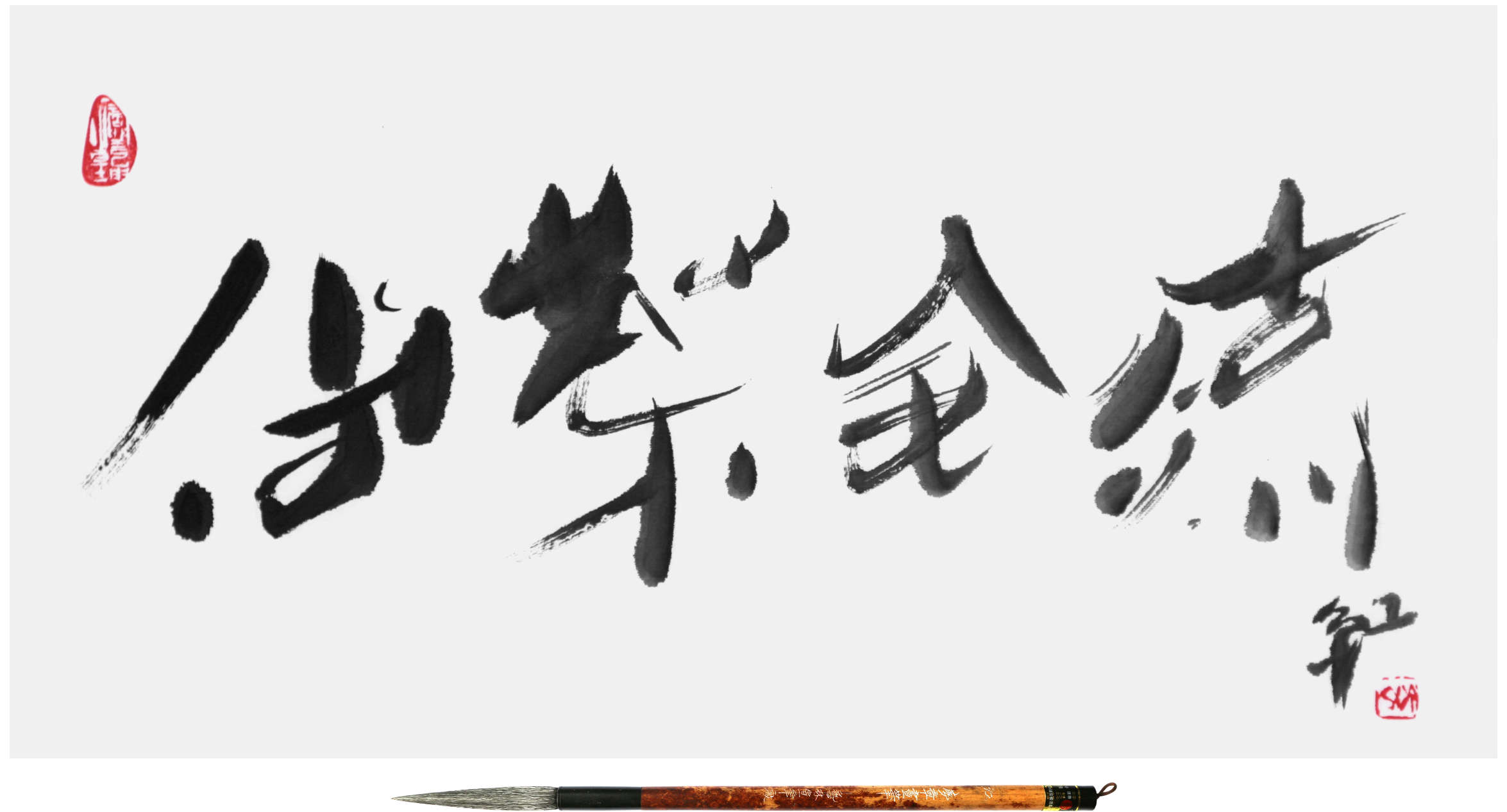 |
|
|
The Example of Sai Koh (Qi
Hong)’s Freehand Brushwork Traditional Chinese Painting and
Calligraphy on Tea:
Chinese
calligraphy (semi-seal script calligraphy), Chinese seal
engraving (Chinese seal carving, Chinese seal cutting)
Exaltation of the Tea is Literary and Excellent
ink on Xuan paper, 2017
Pinyin: shang cha feng liu; Chinese, 尚茶風流 紅
(Literary quotation:Tea Classic by Lu Yu in the Tang
Dynasty, which quotes Lu Na Advertised Frugality and
Simplicity with Tea in Zhongxing Shu in the Jin Dynasty )
Seal: Sai (Qi); Chinese, 齊 A Drop of Water
Moistens the Universe; Chinese, 一滴潤乾坤
Xuan Paper: Mian Liao Mian Lian, 69×34cm
Brush: Goat Hair Long Head Brush, Meng Zhang
Hua Bi · Jiang
|
|
|
The Unique
Embodiment of “Time Clarity” – “Recording and Reproduction of
Static Time and Interval Time”
The basic carrier of traditional Chinese painting and
calligraphy is “water”, whose unique possibility of recording
and reproducing the staticity and interval time is superior to
other carriers.
“Water” itself is invisible, permeable and diffusible. When the
writing brush that carries water moves, the "water trail"
seeping on the rice paper can record and reproduce the "moving
time" of the writing brush; the diffusing "water halo" makes it
possible to visually feel the recording and reproduction of the
"static time and interval time" of the writing brush.
When the water contained in the writing brush head falls on the
rice paper and stays still, due to the difference of the water
content of the writing brush head and the standing time,
different sizes of “water halo” will generate due to water
diffusibility; When the existing “water halo” is overlapped, due
to the difference of the interval time, the “water halo” that
diffuses each other or unilaterally or overlap will appear. This
ability to record and reproduce no movement change between the
start and the end of wielding the writing brush, the length of
the "static time", and the length of the "crossover, overlapping
sequence and interval time" is the unique excellent
characteristic of "water" as the basic carrier of traditional
Chinese painting and calligraphy.
|
|
|
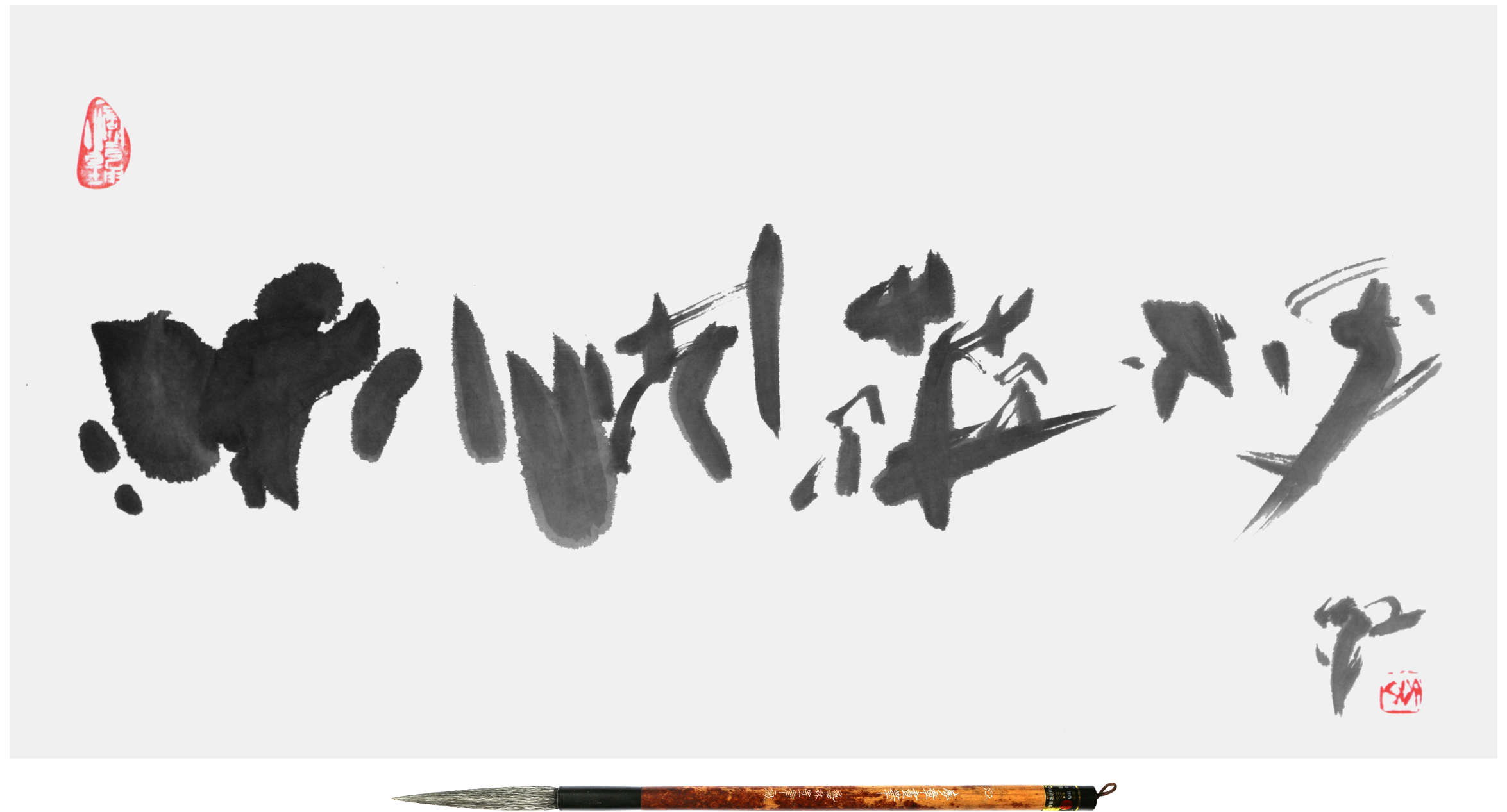 |
|
|
The Example of Sai Koh (Qi
Hong)’s Freehand Brushwork Traditional Chinese Painting and
Calligraphy on Tea:
Chinese
calligraphy (semi-seal script calligraphy), Chinese seal
engraving (Chinese seal carving, Chinese seal cutting)
Tea Dust is Down and Essence is Up
ink on Xuan paper, 2018
Pinyin: mo chen hua fu; Chinese, 沫沈華浮 紅
(Literary quotation: Chuan Fu by Du Yu in the Jin
Dynasty )
Seal: Sai (Qi); Chinese, 齊 A Drop of Water
Moistens the Universe; Chinese, 一滴潤乾坤
Xuan Paper: Mian Liao Mian Lian, 69×34cm
Brush: Goat Hair Long Head Brush, Meng Zhang
Hua Bi · Jiang
|
|
|
The Innate
Excellent Characteristics of “Water”- The Completeness and
Fineness of "Time Recording and Reproduction"
If the "water trail" exuded by the moving writing brush head on
the rice paper is likened to "subjective spiritual movement",
the "water halo" diffused by the static writing brush head is
likened to "movement of energy produced by the enrichment of
spirit", it can be visually understood that the exudation of
"trail" and the diffusion of "halo" do not exist independently
of each other but are a natural unity that features a
coordinated action from without and within and that integrates
spirit and energy.
When recording and reproducing time with ”water halo", it is
possible to record and reproduce "moving time, static time and
interval time" at the same time without omission, which is an
excellent feature of traditional Chinese painting and
calligraphy carrier that is inherently superior to other
carriers that can only record "moving time".
Traditional Chinese painting and calligraphy is a plane image
composed of handwritten “water trail” line drawing. And the
thickness, thinness, wetness or dryness of water embodied by ink
and the overlapped irreversible ink colors not only reflect the
static shape but also faithfully and meticulously record and
reproduce the “moving speed, fluctuation range, turning speed,
pause duration, overlapping sequence and interval length" of the
writing brush. This makes it possible to clearly visualize the
author's physical and mental state at the time of creation. The
excellent feature of "water" that can record and reproduce the
delicacy of creation at that time is unattainable by other
carriers.
Traditional Chinese painting and calligraphy place extra
emphasis on the use of Chinese characters or the tangible form
of objective images to write the intangible artistic conception
pursued by subjective aesthetics. In terms of specific
techniques, "water" is used to record and reproduce the time
clarity that is consistent to the aesthetic pursuit and reflects
the artist's physical and mental state at the time of creation.
The completeness and delicacy of "water" in recording and
reproducing time provide the possibility space for the realistic
reproduction of the visual experience that can not be replaced
by other carriers for the time clarity of the irreversible
physical and mental state in the artist's creation.As the
carrier of traditional Chinese painting and calligraphy, "Water"
has innate excellence in recording and reproducing time, which
not only makes me often praise and admire the greatness of
Chinese civilization and the wisdom of ancestors but also
motivates me to make more efforts to inherit and carry forward
traditional Chinese painting and calligraphy art.
|
|
|
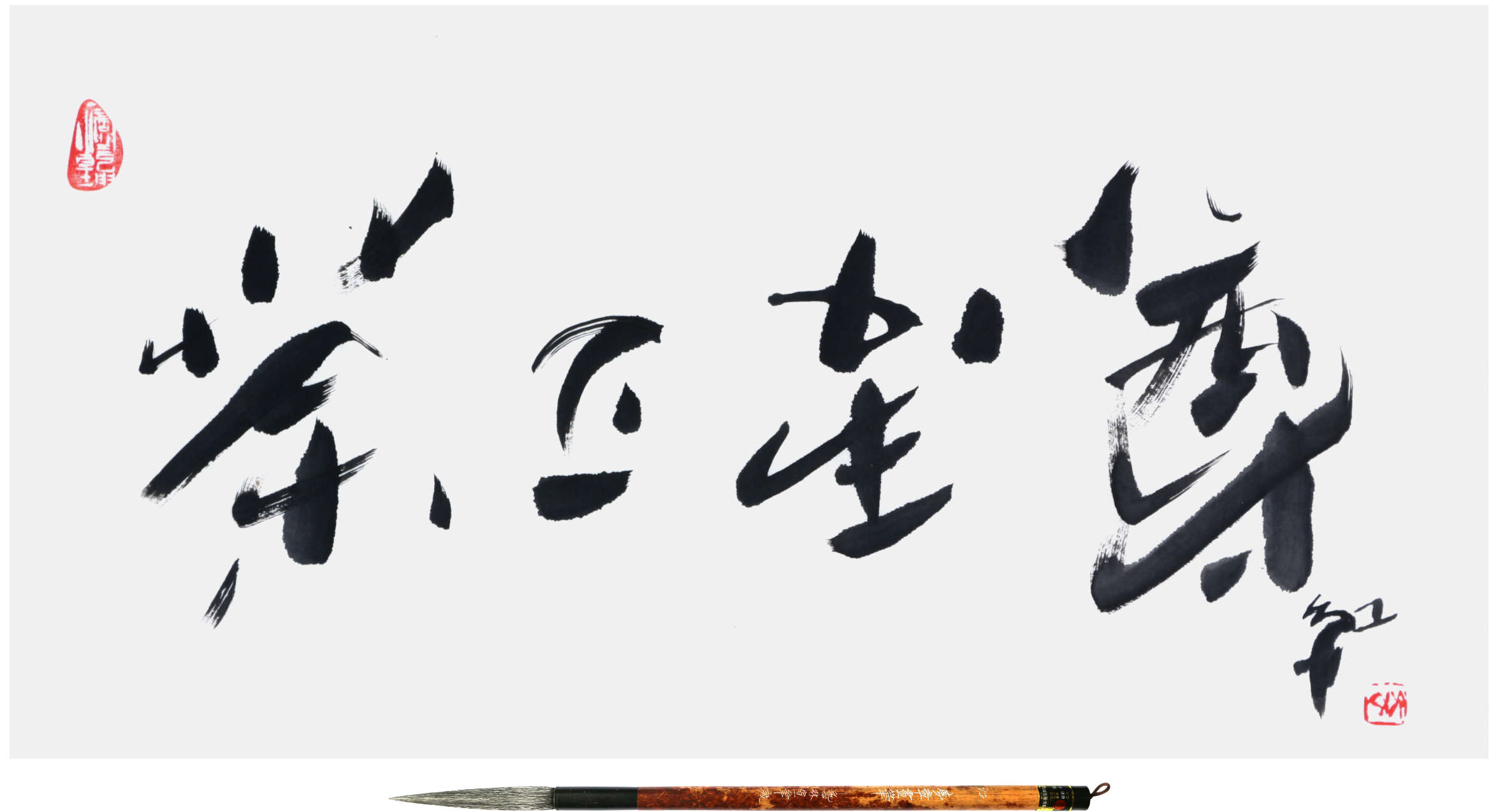 |
|
|
The Example of Sai Koh (Qi
Hong)’s Freehand Brushwork Traditional Chinese Painting and
Calligraphy on Tea:
Chinese
calligraphy (semi-seal script calligraphy), Chinese seal
engraving (Chinese seal carving, Chinese seal cutting)
Tea Hospitality Towards the Supremacy
ink on Xuan paper, 2018
Pinyin: cha shang zhi zun; Chinese, 茶上至尊 紅
(Literary quotation: Tea Classic made by Lu Yu in the
Tang Dynasty, which quotes Xu Sou Shen Ji·Emperor Jinwu
in the Jin Dynasty)
Seal: Sai (Qi); Chinese, 齊 A Drop of Water
Moistens the Universe; Chinese, 一滴潤乾坤
Xuan Paper: Mian Liao Mian Lian, 69×34cm
Brush: Goat Hair Long Head Brush, Meng Zhang
Hua Bi · Jiang
|
|
|
|
|
Throw Away a Brick in order to Get a Gem
The flooding of the Yangtze River made Liangzhu culture
disappear under the soil layer, and Xia Yu's water control
enabled the continued development of Yangshao culture and the
birth of the first dynasty civilization in Chinese history. As
early as the Yin and Shang dynasties, Yi Yin, who was regarded
as the ancestor of the Chinese chef by future generations,
clearly summarized the traditional Chinese culture with "Water
is the beginning of all tastes". Water control and water use can
be said to be an eternal pursuit and subject throughout the
development of Chinese society and civilization.
In today's era where 3D printers can even print human figures,
how to inherit and promote the traditional Chinese painting and
calligraphy art featuring the use of tangible forms to write
intangible things, consistency in brush strokes, vividness in
form and spirit and expressiveness in freehand brushwork. In my
humble opinion, the traditional Chinese painting and calligraphy
art is objectively inseparable from water, which is the basic
carrier of its innate excellence. Water can make the subjective
and objective resonate, record and reproduce time faithfully,
delicately, completely and clearly, and make the visual
experience possible.
I sincerely hope that the traditional Chinese painting and
calligraphy art will change with each passing day and be
permanently brilliant!
The above is my superficial view . Please favour me with your
valuable opinions!
Written by Sai Koh (Qi Hong) on September 2016
|
|
View 1
View 2 |
|
|







